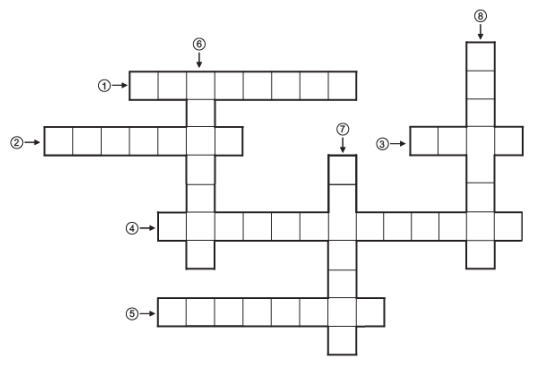Formative Assessment: Understanding Quadrilaterals | Advance Learner Course: Mathematics (Maths) Class 7 PDF Download
Question 1: Complete the following crossword puzzle using the given directions for Across [from left to right] and Down [from top to bottom].
Directions:
Across: (1) The points where the sides of a polygon meet are called __________.
(2) A polygon made by six sides is called a __________.
(3) The side joining two vertices is called a __________.
(4) A four sided polygon is called a __________.
(5) A five sided polygon is called a __________.
Down:
(6) A parallelogram having all of its four sides equal is called a __________.
(7) A simple closed figure made of only line-segments is called a __________.
(8) The line segment joining the opposite sides of a polygon (except-triangle) is called a __________ of the polygon.
Question 2: Match the following:
Column A | Column B |
(a) The parallelogram that is inscribed in a circle is a ____ | (i) Square |
(b) The parallelogram having all of its sides equal is called a_______ | (ii) Rectangle |
(c) The diagonals of a quadrilateral are unequal and bisect each other necessarily at right angles. It is a _____ | (iii) Kite |
(d) The diagonals of a parallelogram are equal and bisect each other at right angles. It is a ______ | (iv) Rhombus |
Question 3: Choose the appropriate answer:
(i) Which of the following is a regular quadrilateral? (a) a rhombus (b) a square (c) a rectangle (d) a parallelogram
(ii) Which of the following is not a parallelogram?
(a) square (b) Trapezium (c) Rhombus (d) Rectangle
(iii) Which of the following quadrilateral is having every internal angle equal to 90 °
(a) Rhombus (b) parallelogram (c) kite (d) Rectangle
(iv) Which of the following is the sum of an exterior angle and its adjacent interior angle?
(a) A straight angle (b) A right angle (c) A complete angle
Question 4: Answer the following questions:
(i) For a regular polygon of n sides (n—2) × 180° is the measure of the sum of its interior angles or exterior angles?
(ii) If the sum of all the exterior angles of a quadrilateral is 360° then what is the sum of all the exterior angles of an octagon?
(iii) Tetragon is the other name of which polygon–a quadrilateral or a triangle?
(iv) What do we call a trapezium having its nonparallel sides equal?
Answers
1. (1) → VERTICES
(2) → HEXAGON
(3) → EDGE
(4) → QUADRILATERAL
(5) → PENTAGON
(6) → RHOMBUS
(7) → POLYGON
(8) → DIAGONAL
2. (a) → (ii) (b) → (iv) (c) → (iii) (d) → (i)
3. (i) (b) (ii) (b) (iii) (d) (iv) (a)
4. (i) Sum of interior angles
(ii) 360°
(iii) A quadrilateral
(iv) An isosceles trapezium
|
41 videos|45 docs|9 tests
|
FAQs on Formative Assessment: Understanding Quadrilaterals - Advance Learner Course: Mathematics (Maths) Class 7
| 1. What are quadrilaterals? |  |
| 2. How many types of quadrilaterals are there? |  |
| 3. What is the difference between a parallelogram and a rectangle? |  |
| 4. How can I determine if a quadrilateral is a square? |  |
| 5. What are the properties of a rhombus? |  |
|
41 videos|45 docs|9 tests
|

|
Explore Courses for Class 7 exam
|

|

















